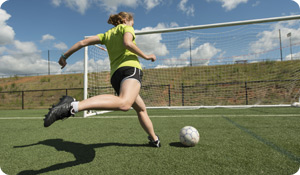
While youth sports can improve a child’s cardiovascular health, strength, and speed, it also can put them at greater risk of certain types of injuries. Here are a few common injuries that kids, parents, and coaches need to watch out for:
1. Concussions
If a young athlete suffers a blow to the head, either during a collision or while falling, he or she may sustain a concussion. This occurs when the brain reverberates inside the skull, causing symptoms such as headache, nausea, fatigue, and difficulty concentrating. These symptoms can last from days to weeks or even months. Concussion has been in the news a lot lately, especially after the revelation that many professional football players have suffered lasting damage from repeated blows to the head. And parents, coaches and doctors have responded by urging greater oversight on the field and during recovery.
And if an athlete does sustain a hit? "When in doubt, hold them out," urges Vijay Jotwani, MD, a primary care sports medicine physician who practices at Houston Methodist Hospital. Jotwani echoes the oft-cited rule about not letting kids continue playing if they’ve hit their head during a game. Receiving a second blow before fully recovering from the first can prolong symptoms and can even be fatal.
The Fix: Can you prevent concussion in the first place? Probably not in all cases, although well-fitting helmets for all sports can help. Another good idea is a formal program of neck-strengthening exercises; these can enable an athlete to absorb some of the force generated during a blow to the head; ideally, the brain is jostled less if the neck is stronger.
Treatment for concussion usually includes avoiding activities that bring on or worsen symptoms, such as exercise; sitting in noisy, bright classrooms; engaging in cognitive activities such as homework or reading; playing video games; and watching TV.
2. ACL Tears
Tears of the anterior cruciate ligament (ACL), one of the main ligaments (the tissue that holds bones together) in the knee, are fairly common. Girls, especially those who play soccer, experience them at more frequently than boys do. "It’s a concern in women because of biomechanics [the structures and functions of the body; in this case, women's pelvic structures] and how they land," Jotwani says.
The Fix: Young athletes at risk of ACL tears—which includes all girls who play soccer—will benefit from a warm-up program before beginning any physical activity as well as physical therapy specifically to strengthen the knee area. A partially torn ACL may heal with physical therapy, but a completely torn one often requires surgery.
3. Overuse Injuries
In general, the more your young athlete engages in a particular exercise, the higher the potential for injury. This is why Jotwani often sees baseball players, who spend a lot of time throwing, with elbow and shoulder problems. Kids on the track team who run every day may sustain stress fractures in the bones of their feet and ankles. "Specialization is a risk," Jotwani says, since single-sport athletes often make lots of repetitive movements. As Jotwani points out, "[There’s] overuse of certain muscles and lack of development of other muscles."
The Fix: Mix it up by having your child participate in more than one sport, if possible. Or at least encourage her to cross-train by strengthening different muscles or doing a different type of workout on days when she doesn’t have team practice. This will protect her muscles and joints and make her a better all-around athlete.
4. Growth-Plate Injuries
During puberty, bones grow in only one or two spots, known as the growth plates. If a growth plate is near a tendon (the tissue that connects muscle to bone), the stress of exercise can irritate the plate and make it more susceptible to injury. A common condition among active adolescents is known as Osgood-Schlatter, which can cause inflammation and pain in the knee. Boys are more susceptible to Osgood-Schlatter, but the difference between the sexes is closing as more girls participate in sports. Growth-plate injuries also can occur in the wrist, ankle, foot or hip.
The Fix: "The best way to prevent such injuries is avoid overuse," says Jotwani, who stresses that it’s particularly important for baseball players. He recommends avoiding repetitive activities and taking time off from sports when possible.
Vijay Jotwani, MD, reviewed this article.
Sources
Jotwani, Vijay, MD. Phone conversation with source on January 7, 2016.
"Questions and Answers About Growth Plate Injuries." National Institute of Arthritis and Musculoskeletal and Skin Diseases. May 2014.
"Concussion." National Institutes of Health/U.S. National Library of Medicine. January 14, 2016.
"ACL Injury: Does it Require Surgery?" American Academy of Orthopaedic Surgeons. September 2009.





